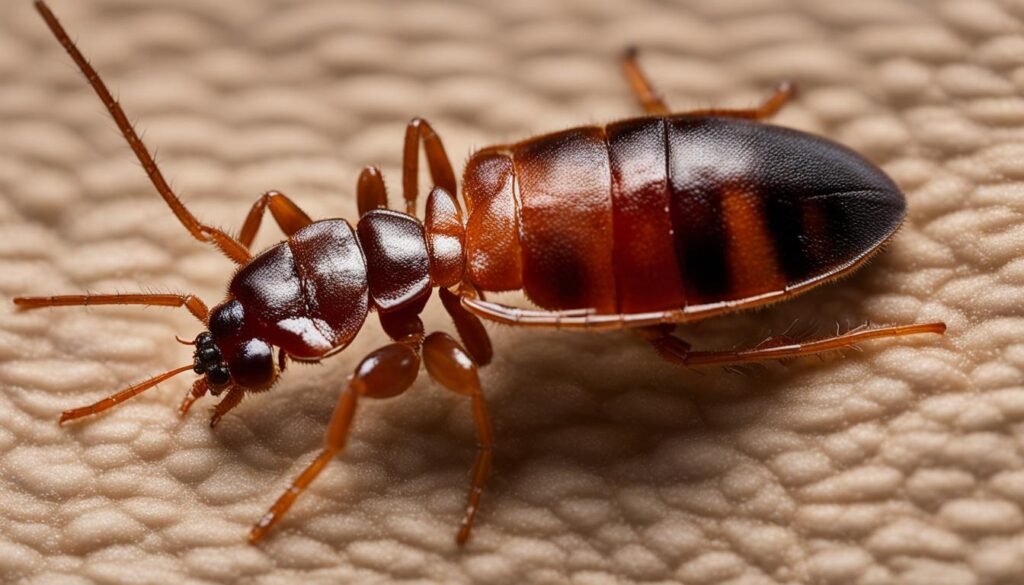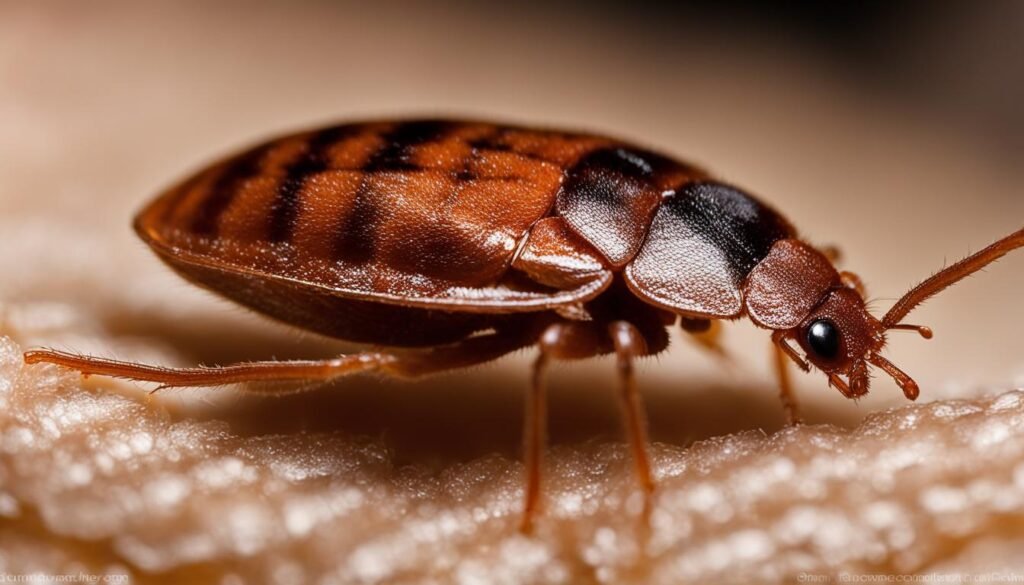What is the Biggest a Bed Bug Can Get?
Table of Contents:
Bed bugs are notorious pests that can cause significant discomfort and itching. But how big can they get? Understanding the size of bed bugs is crucial for identifying and managing infestations effectively.
Bed bugs can vary in size depending on their age and life cycle stage. Adult bed bugs are typically around 1/4 to 3/16 of an inch in length, which is similar in size to an apple seed. Their size can appear larger after feeding, as their bodies become engorged and more cylindrical.
However, in their early stages of development, bed bugs are very small and can be as tiny as a pinhead. It takes around six weeks for bed bugs to reach their adult size, and during this time, populations can grow unchecked.
Understanding the different stages of bed bug growth and their sizes is crucial for identifying and managing infestations. Let’s dive deeper into the size variations and growth stages of bed bugs.
What is the Biggest a Bed Bug Can Get? | Key Takeaways:
- Adult bed bugs are typically 1/4 to 3/16 of an inch in length, similar to an apple seed.
- In their early stages, bed bugs can be as small as a pinhead.
- Bed bugs grow from eggs through nymph stages before reaching adulthood.
- Proper identification of bed bug size is important for managing infestations effectively.
- Contact professional pest control services for a thorough inspection and customized treatment options if you suspect a bed bug infestation.
The Size of Bed Bugs at Each Stage
Bed bugs go through several stages of growth during their life cycle. Understanding the size variations at each stage is essential for identifying and managing infestations. Let’s take a closer look at the measurements of bed bugs at different growth stages:
Eggs:
At the beginning of their life cycle, bed bugs start as tiny eggs. These eggs are about the size of a pinhead, measuring approximately 1 mm.
Nymphs:
As bed bugs progress from eggs to nymphs, they go through several growth stages. Here are the measurements of bed bugs during each nymph stage:
| Nymph Stage | Size (Approximate) |
|---|---|
| 1st Stage Nymphs | 1.5 mm |
| 2nd Stage Nymphs | 2 mm |
| 3rd Stage Nymphs | 2.5 mm |
| 4th Stage Nymphs | 3 mm |
| 5th Stage Nymphs | 4.5 mm |
Adult Bed Bugs:
After completing the nymph stages, bed bugs reach adulthood. Adult bed bugs measure between 5 to 7 mm or 3/16 to 1/4 inch in length, which is comparable to the size of an apple seed.
Measuring the size of bed bugs at each stage can assist in identifying and differentiating the various life cycle stages during an infestation. By understanding these size variations, you can better assess the severity of an infestation and implement appropriate measures for effective bed bug control.
Visual Identification of Bed Bugs
Apart from their size, other characteristics can help in visually identifying bed bugs. Adult bed bugs have flat, oval-shaped bodies and are typically reddish-brown. However, their color can vary depending on whether they have recently fed on blood or not. Before feeding, they may appear translucent or nearly colorless. Bed bugs have six legs, antennae, a small head, and an abdomen. They do not have wings and are unable to fly or jump. Due to their ability to hide and their small size, it can be challenging to see bed bugs with the naked eye. It is recommended to use a microscope or hand lens for proper identification. Other signs to look for include blood marks, feces, and clusters of brown or black spots on mattresses and sheets.
| Identification Factors | Description |
|---|---|
| Size | Adult bed bugs are 1/4 to 3/16 of an inch long, similar to an apple seed. |
| Color | Adult bed bugs are typically reddish-brown, but their color can vary based on feeding. |
| Shape | Flat, oval-shaped bodies. |
| Legs | Six legs, no wings. |
| Ability to Fly | Bed bugs cannot fly or jump. |
| Hidden Behavior | Bed bugs are skilled at hiding in cracks, crevices, and furniture. |
| Microscopic Identification | Use a microscope or hand lens for accurate identification of small bed bug specimens. |
Identifying bed bugs involves observing their physical characteristics and looking for signs of their presence, such as blood marks and feces. It is essential to properly identify bed bugs to effectively address and eliminate infestations.
Mistaken Identity: Bed Bugs vs Other Pests
Bed bugs are often mistaken for other pests, such as mites, bat bugs, and swallow bugs. However, there are distinguishing factors that can help differentiate bed bugs from these insects.
Unlike mites, bed bugs have six legs and a distinct body shape. They also do not have wings or jump.
Bat bugs, on the other hand, are less common than bed bugs and are typically associated with bats.
Proper identification by a trained professional is recommended to accurately determine if an infestation is caused by bed bugs or other similar insects.
DIY bed bug control is not recommended due to the difficulty in identifying these creatures without proper training.

Testimonials
“I thought I had bed bugs, but it turned out to be mites. Understanding the differences helped me get the right treatment!” – Jane Smith
“I called a professional to identify the bugs in my apartment, and it turns out they were bat bugs. I’m glad I didn’t attempt to handle it on my own.” – John Doe
Accurate identification is crucial for effective pest control and ensuring the appropriate measures are taken to eliminate the infestation.
Spotting Bed Bugs and Infestations
While bed bugs can be small and hard to spot, there are visible signs that indicate their presence and an infestation. It’s important to be aware of these signs so that you can take prompt action to address the issue. Here are some key indicators to look out for:
- Identifying Bed Bug Bites: One of the initial signs of a bed bug infestation is the presence of bites on your body. Bed bug bites are often itchy and appear in clusters or rows on areas of exposed skin. They are typically found on the arms, neck, or head. If you notice these bite marks, it’s essential to investigate further for other signs of bed bugs.
- Visible Signs of Bed Bugs: Rusty stains or spots on your sheets, mattresses, or walls could be indications of bed bug activity. These stains are caused by crushed bed bugs or their fecal matter. Bed bug feces often leave clusters of brown or black spots, especially along the seams of mattresses. Check these areas thoroughly for any signs of infestation.
By recognizing these visible signs of bed bugs, you can confirm their presence and take the necessary steps to address the infestation. It’s important to remember that bed bugs are not a sign of poor hygiene or cleanliness. They can infest any environment and are excellent at hiding in crevices and cracks.
If you suspect a bed bug infestation, it’s recommended to contact professional pest control services for a thorough inspection and customized treatment options. Prompt identification and treatment are crucial to prevent infestations from spreading and causing further issues. Taking proactive measures can help you regain peace of mind and ensure a safe, pest-free living environment.

What is the Biggest a Bed Bug Can Get? | Conclusion
Understanding the size variations of bed bugs at different stages of their life cycle is crucial for identifying and managing infestations. Adult bed bugs range from 1/4 to 3/16 of an inch in length, similar to the size of an apple seed. However, they start as tiny eggs and progress through nymph stages before reaching adulthood. By being aware of the size differences, you can better recognize and address a bed bug problem.
Distinguishing bed bugs from other pests is also important in effective pest control. Proper identification helps in determining the right treatment methods. Additionally, recognizing visible signs of infestations, such as bed bug bites, crushed bugs, and excrement stains, can alert you to the presence of an infestation.
If you suspect a bed bug infestation, it is highly recommended to seek professional pest control services. Experienced professionals can conduct a thorough inspection, accurately identify the pests, and provide customized treatment options. Prompt action and professional intervention are crucial for effective bed bug removal and preventing further infestations.
FAQ
What is the biggest a bed bug can get?
Adult bed bugs can grow up to 1/4 to 3/16 of an inch in length, which is similar in size to an apple seed.
What are the different stages of bed bug growth?
Bed bugs go through several stages of growth, starting from eggs to nymphs and eventually reaching adulthood.
How big are bed bugs at each stage of their life cycle?
Bed bug sizes vary at each stage. Eggs are tiny, about the size of a pinhead, while adult bed bugs measure between 5-7 mm or 3/16-1/4 inch.
How can bed bugs be visually identified?
Adult bed bugs have flat, oval-shaped bodies and are typically reddish-brown. They have six legs, antennae, and an abdomen. They do not have wings.
What distinguishes bed bugs from other pests?
Bed bugs can be distinguished from other pests by their body shape, leg count, and the ability to fly or jump. Unlike mites, bed bugs have six legs and a distinct body shape.
What are the visible signs of bed bugs and infestations?
Visible signs of bed bugs include blood stains, feces marks, and clusters of brown or black spots on mattresses and sheets. Bed bug bites on the body can also indicate infestation.
How can bed bug infestations be treated?
Prompt identification and professional pest control intervention are crucial in effectively treating bed bug infestations.